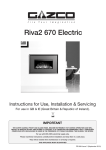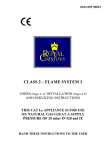Download Models: LFi2T & LFi4T
Transcript
INSTRUCTION GUIDE Amina Technologies Ltd Models: LFi2T & LFi4T Amina Life-Fidelity™ Series 100V/70V plaster-in-wall and in-ceiling loudspeaker Amina Technologies Ltd Cirrus House Glebe Road Huntingdon Cambridgeshire PE29 7DX T+44(0)1480 354390 F+44(0)1480 356564 E [email protected] W www.amina.co.uk ® T E C H N O L O G I E S L t d 02 Thank you for purchasing an Amina® Technologies product We recommend that you spend a few minutes reading this guide, which has been written to help you get the most from your purchase. Safety Warning: Never connect this product directly to the mains electrical supply! Fragile Electronic Equipment: This Amina® product is a sensitive piece of electronic equipment, please take great care of it. Damage will occur with harsh treatment. Unpacking: Unpack your Amina® Life-Fidelity™ Plaster-in-wall loudspeaker (abbreviated 'In-wall Loudspeaker' in this document) with care. Visually check the product and, in the event of transit damage, immediately inform your supplier. We suggest retaining your packaging to transport the product safely at a later date. Contents: This carton contains four white plastic mounting lugs to every one Amina® In-wall Loudspeaker. Please Note: In order to protect this device from excessive low frequency audio energy, this product must be used in conjunction with a high pass filter set at 80Hz or higher and with an attenuation rate of at least 24dB/octave. Amina's own AF2/80 or AF2/150 active filters are ideal. AF2 Highpass filter 24dB Octave Sound Pressure Levels (SPL) 30 Effect of using an AF2 High Pass Filter: Bass content of signals eliminated from panel 20 10 0 10 75 100 1000 10k 100k Frequency Once Plastered into position: Please avoid pushing the wall or ceiling surface immediately in front of this In-wall loudspeaker. Excessive excursion, whilst unlikely to damage the loudspeaker, may lead to cracking of the plaster around the perimeter of the product. 03 Introduction: The Amina® Life-Fidelity™ technology utilises a revolutionary 'diffuse source' vibrating soundboard technique (like that of a traditional acoustic musical instrument) to reproduce high quality, high clarity, highly intelligible sound, even in acoustically reflective areas where conventional cone 'point source' loudspeaker systems generally under perform. Don't worry, these surface vibrations are absolutely tiny and cannot be seen with the naked eye, but they will be detected by our more sensitive touch sense. The majority of the sound energy generated by this 'diffuse source' vibrating soundboard technique is incoherent (or non-phase related), whereas the conventional 'point source' loudspeaker generates a coherent (or phase related) sound wave. Whilst this diffuse energy is unseen and its effects are not immediately obvious, this is important in acoustically 'live' spaces and in the way our brains interpret sound (the complex science of psychoacoustics). Please note that this In-wall loudspeaker product by itself is not a direct replacement for a conventional full range loudspeaker system. In 'hi-fi' and home theatre listening applications a low frequency driver or sub bass may be required to 'lift' the bottom end of the frequency spectrum. This is easily done as the direction of such low frequencies are not detected by the human ear, allowing such a device to be placed in the most convenient and unobtrusive of locations. For general background music listening and voice reproduction, this product is generally sufficient to be used alone. Harrogate House: Amina In-wall Loudspeaker Panels were installed in the living space to be used with the television and surround sound system 04 Amina versus ordinary speakers: Amina® Life-Fidelity™ Characteristics: Before installation you should be aware of the basic characteristics of the Amina® Life-Fidelity™ 'diffuse source' technology. This will help you to get the best results from the product and enable long term, reliable operation in your chosen application. Sound radiates in all directions: Sound dispersion from an Amina® Life-Fidelity™ 'diffuse source' product is generally spherical in shape across most of the frequencies it reproduces. The positioning of the product is therefore much less critical than with conventional 'point source', inherently directional, cone loudspeakers. There is no need to angle this product to a specific direction, its height is far less relevant and can be placed in any orientation or plane. Polar plot of an Amina LFi2T Diffuse Source Loudspeaker 05 The Sound pressure level fall off is more gradual off axis and in a bounded space: Sound pressure level (S.P.L.) from a conventional 'point source' cone loudspeaker falls off dramatically as the listener moves away from the speaker. This is more true than ever when listening 'off-axis' (i.e. not directly in front of the cone speaker). However the S.P.L fall off from an Amina® Life-Fidelity™ 'diffuse source' product is much less severe with distance, especially when listening off axis. In fact, the larger the vibrating soundboard area, the greater the distance it is possible to move away from the panel (or 'source') without showing an appreciable loss in S.P.L. This is very much the case when the whole of the stud wall, or ceiling, in effect becomes the vibrating surface. The situation improves further when an Amina® Life-Fidelity™ 'diffuse source' panel is used in an acoustically reflective bounded environment (e.g. conservatory, pool area, or room containing very little soft furnishings). Here, the reflected phase incoherent energy is generally constructive, contributing to the overall S.P.L, generating a very even 'sound-fill' across a given bounded space. Conventional Loud Speaker: Amina Flat Panel - NXT Technology: Fall off - volume level with distance Sound Pressure Level (SPL) on ax is of fa xi s Distance Sound Pressure Level (SPL) on axis off a xis Distance Radiated sound energy is random, diffused and highly dispersed: Conventional cone 'point source' loudspeakers radiate sound energy that is phase related. This is analogous to the ripples formed when dropping a pebble into still water. Reflections from boundaries are highly correlated with the energy from the original source. Additions and cancellations occur helping to create a variety of problems including room response, reverberation, poor intelligibility and feedback when used with open microphone channels. The radiated sound from an Amina® life-Fidelity™ 'diffuse source' panel loudspeaker is essentially random in nature, non-correlated and significantly less phase related. Reflected energy is principally constructive, creating a very even sound pressure across the entire space. Reverberation, room response and microphone feedback are generally reduced and intelligibility is generally improved over a much wider area due to the very different intermodulation effects that take place with a diffuse energy source. Visual appearance can be matched to the surrounding decoration: Aesthetically the concept of a thin flat panel allows greater creativity in visually disguising the product to merge into any room aesthetic. This is particularly true of the Amina® Plaster In-wall loudspeaker range, which offers zero visibility and therefore zero interference with interior design. 06 Amina® bespoke service: For situations where Plaster In-wall or In-Ceiling panel loudspeakers are not appropriate, Amina® provide a bespoke manufacturing and customisation service. Panel loudspeakers can be painted, veneered, flocked or have a laminated print (containing the image of the clients choice) mounted to its surface. Please ask your supplier for details. Amina® can also provide a full custom service, designing and making any size and shape panel loudspeakers according to client specifications. Applications: Amina® In-wall or In-Ceiling loudspeakers are ideally suited for multi-room entertainment and home cinema/theatre reproduction in the home, and for background to foreground entertainment systems and voice reinforcement (eg. paging, retail, corporate, conferencing, hotel, restaurant, worship and other leisure venues). It is particularly useful (in both home and commercial premises) in wet areas, e.g. swimming pool, garden areas and bathroom ceilings, where the plaster and any surface coatings serve to isolate the Amina® In-wall loudspeaker from the humid zone, combining high quality sound reproduction and zero architectural visibility in humid environments whilst avoiding any long term corrosion issues. Product Positioning and Quantity Requirements: Residential Installation ® In residential environments Amina Plaster In-wall or In-Ceiling loudspeakers are ideal for application within stud walls or plasterboard ceilings. It can also be set into solid wall structures, although this can involve considerable building work to create a suitable aperture to mount the product within. The minimum depth of opening required in a stud wall, ceiling or solid wall, is 50mm from the wall or ceiling front surface. There is no maximum depth requirement. In the home, the position and number of Amina® Plaster In-wall or In-Ceiling loudspeakers is generally determined by the audio format being reproduced. In a stereo listening situation, two panels will be required; in a 5.1 surround sound application, 5 panels will be required; in a 7.1 surround sound application, 7 panels. The product positioning follows the general requirements of each of those system types. One left of and one right of, and in front of the general listening position for stereo. One left of, one central to and one right of, and in front of the general listening position, together with one right of, and one left of and to the rear of the general listening position for 5.1 surround sound. Of course real room layouts seldom provide ideal locations, especially considering the numerous listening or seat positions generally requiring coverage. The advantage of this type of 'diffuse source' loudspeaker is that the speaker position and listening position are far less critical, making them ideal for 'real' rooms. The following schematics give a few ideas on typical positions to be adopted in stereo and 5.1 surround applications in a series of real life rooms. 07 Lounge system set-up X Bedroom system set-up X X X Ceiling Mount 5.1 X Ceiling Mount 5.1 X X Swimming Pool room layout X X X X X Ceiling Mount Stereo Ceiling Mount Stereo for music X X X X X X X X X X Panels positioned in ceiling above pool area X X Optional front & rear positions Optional front & rear positions on wall X X Wall Mount 5.1 Wall Mount 5.1 X X Wall Mount 5.1 & sub The awkward room X X X X X X X X X Example: 5.1 Surround Sound in the Bedroom: A good example to pick out here is the bedroom, with a requirement for a 5.1 surround system. Installation of any loudspeaker within a ceiling is generally very easy within a bedroom (assuming a traditional house layout), due to the ease of access through a loft void. However, the use of conventional 'point source' directional loudspeakers is likely to yield poor results as the front set of three speakers situated beyond the foot of the bed are not directionally aimed at the listener. Alternatively, applying the Amina® 'diffuse source' Plaster In-wall or In-Ceiling loudspeakers at the same positions will yield excellent results, as their non-directional qualities will place sound at the listening position even at this acute angle. X X X LiFi units ‘plastered in wall’ TV screen in corner of room Key X Amina Plaster In-wall speaker X Sub bass 08 Product Positioning and Quantity Requirements: Commercial Installation The overriding factor in terms of best product positioning for multiple source installations is, where possible, to evenly space the number of panels across the given space. This will create a very even S.P.L. across the whole environment. The direction, orientation and height are much less relevant. As a general rule of thumb, in ceiling applications, one Amina® Plaster In-Wall loudspeaker will be required every 7 to 10 metres (i.e. covering an area of 49 to 100 square metres). S.P.L. levels measured at the mid point between two panels and 0.6m down (i.e. standing height in a room with a 2.4m high ceiling) will be 6dB lower than when measured directly under the panel. When measured at a distance of 1.1m down (i.e. sitting height) this figure changes to just 3.5dB. Therefore the higher your ceiling the more even S.P.L. coverage will be obtained below it. As a rule of thumb, in wall mount applications, panels positioned every 8m will provide less than 3.5dB SPL reduction measured at the mid-point between panels and at least 1.1m away from the wall, compared with a measurement taken directly in front of the panel and 1.1m away. The measured S.P.L. in the centre of the space compared to the perimeter will depend on the width of the room and the amount of reflective surfaces in the space. X 60m 6m X X X X X X X 10m X X 20m Multipurpose Exhibition, Conference, Worship Hall X: Speaker positions. LFi-T units x 8 units in total Restaurant X: Speaker positions Shaded areas: Sound will be quieter but have excellent quality 09 If you have special requirements please contact your supplier or Amina® for assistance. Sound transmission in buildings and isolation techniques: The actual sound energy generated from the rear of the Amina® Plaster In-wall or In-Ceiling loudspeaker is equal to that generated from its front surface. Superficially this might be thought of as being trapped within the wall or ceiling and, to some extent, this is true. In practice though, some of this energy is transmitted through the rear of the wall and emerges at its opposite face or, in the case of the ceiling, emerges at the floor above. Some will also travel along any internal cavity to emerge in connecting rooms. The wall or ceiling construction will determine how much of this energy is transmitted, and users/installers need to consider carefully the impact this may have on neighbours and other building users before installation commences. If the wall or ceiling consists of a plasterboard and studwork facing a solid concrete floor or block wall structure, sound transmission to the other side of the wall is minimal due to the heavy mass of the concrete / block structure in the centre. If the construction, in the case of a wall, is simply plasterboard on both sides of wooden or metal stud work or, in the case of a ceiling, plasterboard faced joists with wood based floor boarding on the upper surface, then sound transmission is going to be quite considerable, due to the low mass and lack of absorptive material in between. In these circumstances it is worth implementing additional sound isolation techniques within the wall or ceiling prior to installation of the Amina® Plaster In-Wall or In-Ceiling panel loudspeaker. At its most basic, this may be as simple as adding sound adsorbing mineral wool or wadding into the cavity directly behind the panel speaker. Different grades of such materials exist - ask your builders merchant for advice. The quality and increased depth of this material will provide improved isolation. A more sophisticated approach is to create extra mass by forming a box work containment section in plasterboard or other such material behind the speaker, and again fill the space between it and panel with mineral wool. The mineral wool can touch the rear of the panel but should only be resting against it. It should not be packed in tightly enough that it exerts force on Typical ‘stud’ wall with Sound Insullation Plaster board 12mm Wooden frame work/ Plaster board front onto Solid block wall with sound insulation Wooden frame work attached to solid wall LFi-T unit LFi-T unit Sound Insullation Cut-away view of ceiling Incorporating Sound Insulation • LFi-T plastered into ceiling • Box erected around speaker unit - free wire through top • Insulation around and inside box • Secure to main beams Wood frame work Block wall Plaster board Insullation 10 Installing your Amina® life-Fidelity™ In-wall/In-Ceiling Panel Loudspeaker: 12 System Requirements: 1) A high quality 100 or 70V line amplifier. . 2) This product must be fed with a signal that is high pass filtered at 80 Hz (minimum 24dB per octave) to ensure long term reliable operation. This may require a separate piece of hardware (e.g. The Amina AF2 active high pass filter), or this function may be performed by the amplifier itself. 3) It is recommended that you allow for some equalisation (preferably on each individual channel) in your system specification (this may be a separate piece of hardware, or this function may be built into your AV surround processor) to allow adjustment of the final frequency response. Differing plaster depths and wall structures (particularly wall cavities) may alter the frequency response of each panel. Equalisation in each channel makes it possible to compensate for these small differences and achieve optimised audio reproduction from every panel loudspeaker in your system. Electrical connection types available on the Amina® In-wall/In-Ceiling Panel Loudspeaker: The Amina Plaster In-Wall/In-Ceiling Loudspeaker is fitted with a short length of cable terminated with BUTT splice crimp connectors for ultra reliable long term security of operation. Stip back 10mm of insulation on your loudspeaker cable. Position the exposed conductor into the BUTT splice free end. Use a proffessional crimp tool to secure this in place. Always keep your cable polarity (positive to positive) consistent throughout the same installation. If the panel is placed in a stud wall or ceiling that has sizeable cavity space behind it, the resulting sound may be very heavily bass weighted. This bass is generated because the cavity forms its own resonant chamber that is excited by the panel. You may need to adjust your system equalisation to reduce the In-wall loudspeaker lower frequency content to compensate for this. Professional BUTT Splice Installation Fault Finding Guide: It is imperative that, once the product is located into the wall or ceiling, and prior to plastering over, it is fully electrically and acoustically tested to avoid time consuming repairs or modifications at a later stage. The following guide is designed to help in determining possible problem areas, during these tests. No Sound Output: Check that your audio system has power, is turned on and is working. Check that all cables and connections are in tact, and made in the proper manner. Sound output is very low: Check the specification label on the back of the product. Ensure that you are not using a low impedance signal to drive a line transformer based product. With no audio signal applied lightly push the panel in and out at its centre. Listen carefully for rubbing voice coils on the exciter. This may indicate that the unit has been overdriven and subsequently damaged, and needs to be returned to your supplier for repair. Take your system back to the bare minimum (e.g. amplifier, source and speakers) to eliminate faults in other components such as filters, crossovers and equalisers. Check for continuity over cable lengths. Take your system back to the bare minimum (e.g. amplifier, source and speakers) to eliminate faults in other components such as filters, crossovers and equalisers. Distortion at high volume levels: If the problem persists, consult your supplier for after sales service. Diffuse source panel loudspeakers of this type have an extremely fast response, articulating the signal from your electronic drive system very accurately. Distortion, buzzing or rattling sounds at modest volume levels: Take your system back to the bare minimum (e.g. Amplifier, source and speakers) to eliminate distortions introduced by other components such as filters, crossovers and equalisers. Try to identify the location of the buzz or rattle. It may be caused by a loose screw or other mechanical fixing. Check the assembly and ensure screws and fixings are tight. If the rattle persists, remove the panel from the wall and without any audio playing through the panel, shake the loudspeaker gently. If the rattle is evident whilst doing this, check for foreign objects (screws etc.) which may have fallen into the rear of the product and might be resting against the panel or frame. Similarly check your wiring to the product. Ensure that wires, when the product is in the final location, are not resting against the back of the vibrating panel. Again with no audio signal applied lightly push the panel in and out at its centre. Listen carefully for rubbing voice coils on the exciter. This may indicate that the unit has been overdriven and subsequently damaged, and needs to be returned to your supplier for repair. If the problem persists, consult your supplier for after sales service. When using your amplifier at maximum power levels, or if the input of your power amplifier is being overloaded, the signal level may be entering the clipping phase. With some conventional speakers this may not be evident, but with a diffuse source panel loudspeaker this is much more likely to be reproduced in the form of distortion. Consider adjusting or upgrading your drive system. Feedback occurs easily with open live microphone channels: The disperse sound wave generated by a 'diffuse source' panel loudspeaker helps generate a very even sound field in a given space. This can help reduce problems with microphone feedback. However, if you are experiencing feedback with lower gain structures please check the signal equalisation. The acoustics of your space and the reflectivity structures of the walls, windows, floors or ceilings may be creating acoustic standing waves within the room. Adjusting your system equalisation may help reduce feedback dramatically. 14 Further details: Maintenance, Cleaning and Decoration: Once the Amina® Plaster In-wall loudspeaker is plastered into a wall or ceiling it requires no physical maintenance. Your wall or ceiling can be dusted or cleaned with products appropriate to the finish (paint or wallpaper) you have finally applied to the plaster surface. The wall or ceiling can be repainted or redecorated any number of times. Extreme care should be taken when removing wallpaper type coverings to ensure the plaster surface is not damaged or pushed in during removal and renewal of the wallpaper. If damage to the plaster work occurs, use British Gypsum Easi-fill (or similar) to repair the plaster surface prior to re-decorating. Avoid pushing the wall or ceiling surface immediately in front of the panel loudspeaker. Excessive excursion, whilst unlikely to damage the loudspeaker, will undoubtedly crack the plaster around the perimeter of the product. Warranty: This product carries a seven year manufacturers limited warranty. If it fails, please return it to your supplier. Amina® will work with your supplier to ensure any defects are repaired and your product returned to you. This statement does not affect your statutory rights. Reliability: Correctly installed and used within its specification, this product is designed to give many, many years of trouble free service. As a technology, the Life-Fidelity™ 'diffuse source' vibrational soundboard technique has very few moving parts. Compared to a conventional moving coil loudspeaker, these movements are almost negligible. Whilst our sensitive touch sense can feel the tiny movements, they are not sufficient to be seen by the naked eye. As a consequence, the long term reliability of this electromechanical structure is enhanced. Removal: If, however, a problem develops with this product, or you simply want to remove the item to change its location or move it to a new property, then it is relatively straight forward to remove it from the wall or ceiling. By tapping the wall or ceiling, locate the In-wall loudspeaker. Take a decorator’s scraper or sharp chisel. Hold the tool at an acute angle to the wall or ceiling directly over the buried panel loudspeaker. Carefully chip in to the plaster to expose a small area of the panel surface. Now hold the scraper or chisel virtually parallel to the panel and, working out to the product's edge, gently ease the rest of the plaster coat away from the panel surface. Don't worry if the panel surface receives marks or cuts during this process (it should not, however, have holes all the way through the special honeycomb panel). Once the product is plastered back in to its original or new location, the new plaster will cover all these imperfections and the product’s performance will not be unduly affected. Clear the surface plaster material from the surrounding plasterboard to expose all the joint tape covering the join between the panel and the plasterboard. Remove the joint tape and, if necessary, use a sharp knife to cut directly along the panel perimeter to free any material that may be filling the gap between the panels edge and the surrounding plasterboard. Use a narrow chisel or flat blade screw driver to remove the plaster or other filler material to expose the screws at each corner of the product. Using a suitable screwdriver, remove the four screws holding the product in position. Ease the product from the wall or ceiling and disconnect the loudspeaker cable, leaving the fixing lugs in their corner positions. If the product needs repairing, please return it to your supplier, or Amina® directly, for a rapid turn around repair. Once repaired the product can be re-affixed into position following the installation steps detailed above. Ensure new joint tape is used over the join between the panel and surrounding plasterboard and use Easi-fill to plaster over the panel and immediate surrounding area. Once dry, sand down and use a wet sponge to create a flat surface, level with the original surrounding plasterwork. Alternatively if the product is to be moved to a new location or property, you need to make good the opening in your plasterboard wall or ceiling. Carefully remove the fixing lugs and replace them with simple flat rectangle wooden battens of similar size, in the similar location to the previous lugs. In the space left by the panel, fit a sheet of plasterboard (cut to size 400mm x 300mm), attaching it with dry wall screws to the wooden corner battens. Apply joint tape to the perimeter join and use Easi-fill to plaster over the new plasterboard section and immediate surrounding area. Once dry, sand down and use a wet sponge to create a flat surface, level with the original surrounding plasterwork. Re-use the old fixing lugs to fit the product into the new location using the procedure detailed in the Installation section above. If you need new fixing lugs please contact Amina ® for spares stating the thickness of plasterboard the unit is to be fitted to, and your product serial number (noted on the back of the product). 15 Product Specifications: LFi2T LFi4T ` We wish you many happy hours of delightful listening to this unique audio product. If you have any questions or comments, or need any help or advice, we would be delighted to hear from you by phone, letter or email using the contact details opposite. At the end of its useful life, and in compliance with the European directive on waste electrical and electronic equipment (WEEE), this product is to be returned to your supplier, or directly to Amina for recycling. If you have any questions please call Amina for assistance. Customer Services Amina Technologies Ltd Cirrus House Glebe Road Huntingdon Cambridgeshire PE29 7DX T+44(0)1480 354390 F+44(0)1480 356564 E [email protected] W www.amina.co.uk ® This document is Copyright of Amina Technologies Ltd, 2007 Easi-fill is a trademark of British Gypsum Ltd Amina is a registered trademark of Amina Technologies Ltd Life-Fidelity is a trademark of Amina Technologies Ltd T E C H N O L O G I E S L t d INSTRUCTION GUIDE “Sound has never looked so good” Amina Technologies Ltd Cirrus House Glebe Road Huntingdon Cambridgeshire PE29 7DX T+44(0)1480 354390 F+44(0)1480 356564 E [email protected] W www.amina.co.uk ® T E C H N O L O G I E S L t d





























